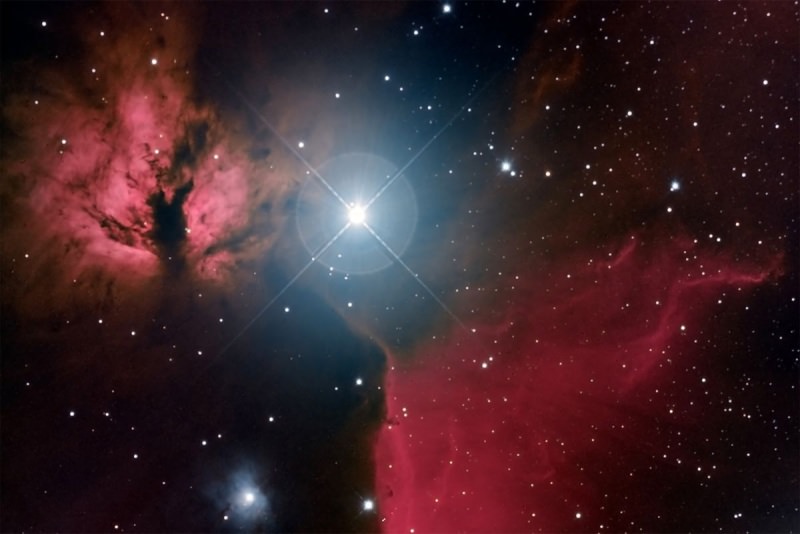Astrophotographer César Cantú from Mexico captured this beautiful view of the star Alnitak and Flame Nebula, both in the constellation Orion. Alnitak is the southern star in Orion’s belt, and is an extremely hot star, with a temperature of 29,500 ± 1000 K. It shines brilliantly, and is about 10,000 times more luminous than the Sun. This star also makes the Flame Nebula appear to be blazing, too. Wind and radiation from Alnitak blasts away electrons from the gas in the Flame nebula, causing it to become ionized and glow in visible light.
This gorgeous view was captured on August 11, 2013.
Want to get your astrophoto featured on Universe Today? Join our Flickr group or send us your images by email (this means you’re giving us permission to post them). Please explain what’s in the picture, when you took it, the equipment you used, etc.


You should try a minus violet filter which may get rid of the poorly corrected blue around Alnitak
like this …
http://pics.cotton.cd/Orion%202.jpg
1990 TSP: 600mm/f4 Newtonian, Olympus OM-1, Gas Hypered Kodak Technical Pan 2415, Lumicon Minus Violet Filter, 50 minutes, Manually Guided (Autoguiders did not yet exist!)., Losmandy GM100-EQ Mount.
Compared to today’s technology, mine is not a particularly spectacular astrophotograph (it is after all emulsion so it is photography). In terms of today and astroimaging world, this is but a “snapshot”. 20 years ago, before autoguiders, focusing aids and CCD’s, this was pretty much state of the art type of stuff.
Single LONG exposure…..no autoguider or dewzapper…..hypered Tech Pan…..LOTS AND LOTS of TRIAL AND ERROR.
Thanks for the memories, astroraider, of the days before CCD imaging.
On a side note, I’ve also photographed this area with GAF 500 slide film(pushed to ISO 1000), Kodak color infrared, 103a-O and 103a-E along with early attempts with good old Tri-X.
… and no focusing aid beyond a knife edge focuser held by a rubber band between the film rails of the camera (camera back removed with the camera shutter open to perform the “test” to insure proper focus … at least at that moment) … a basic focault test … only then do you load the film. Later would come the SureSharp then eventually the Stiletto and Banitoff Masks and such. There were no 10:1 focusers and there was no computer control to adjust the focus based on temperature … and indeed, changing temperatures were a significant factor! Unless you shot between about 1:00 A.M. and 3:00 A.M. (usually the temperature was static during those times) the first exposure was in sharp focus and the rest … not so much. Sometimes the focuse was compromised during the first exposure by expansion/contraction.
No Carbon Fiber then either which is pretty much dimensionally stable with changes in humidity and temperature.
Well sealed Sonatube (used for many Newtonians of the time) was about as close as you got to dimensional stability but you constantly had to reseal it.
Humidity would run off in a constant stream just a few hours after twilight … I remember using a 12V hairdryer to clear off the schmidt corrector (dew/humidity) and then pointing the OTA at the ground for a few minutes so it could reach thermal equilibrium again … then try again. Around 3:50, the temperature would start to rise and the humidity would start to lower and you had a second shot at your target if I wasn’t out of gas physically and if the batteries weren’t out of juice …
Today … well it is entirely different … so very easy for modern astroimagers!!
Great image.. Aug. 11th eh? Must’ve been taken just before dawn?.
Actually, it seems that Alnitak is probably NOT the star responsible for the illumination of the Flame Nebula(aka NGC 2024). From the published studies I’ve read, the source of illumination for the nebula was a mystery for some time. Radio and infrared studies in the 1980s identified a young, heavily obscured star cluster within NGC 2024, members of which were thought to be responsible for the ionizing radiation that illuminates the nebula.
In 2003, a study of this obscured cluster identified a member star, IRS2b, that appears to be the main source of ionizing radiation for the Flame Nebula: http://arxiv.org/abs/astro-ph/0303029
More recently, a polarimetric study of NGC 2024 found additional evidence that the illuminating star for the nebula is indeed IRS2b: http://arxiv.org/abs/astro-ph/0702597/
An image of the IR cluster (including IRS2b) in NGC 2024, taken from the 2003 paper, can be found here: http://arxiv.org/PS_cache/astro-ph/ps/0303/0303029v1.image_astroph.jpg
Not that any of that takes away from César’s amazing image of the region 🙂